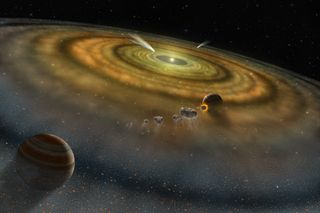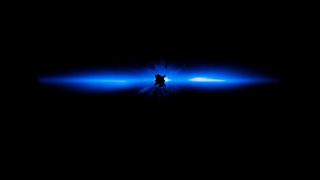The James Webb Space Telescope will witness a shattered world in high definition
Researchers look forward to glimpses of worlds colliding in action from NASA’s state-of-the-art space observatory.
Once the James Webb Space Telescope completes its commissioning period and releases its first operational images on July 12, the observatory will dive into the science in earnest. And one of the telescope’s first year investigations will include a close-up view of Beta Pictoris’ strange surroundings.
The young star, just 63 light-years from us, is surrounded by a dusty disk filled with debris left over from its formation. It is a bustling space, housing “at least two planets [and] piles of smaller rocky objects,” the researchers said in a 2021 press release (opens in a new tab) about the investigation.
Live update: NASA’s James Webb Space Telescope Mission
Related: How the James Webb Space Telescope works in pictures
While research has many directions, one key aspect is observing young planetary systems that evolve when planetesimals (planetary precursors) collide. As Beta Pictoris is covered in dust, the researchers will use Webb’s infrared light to peer through the debris and see what’s happening in high definition.
Webb will have decades of past work to tap into, including ground-based observatories and space observations from the Hubble Space Telescope. We know from such studies that Beta Pictoris hosts at least two giant planets, both much more massive than Jupiter. The researchers also caught a glimpse of the first known exocomet, or comet outside our solar system, circling in a cloud of debris.
But it’s the debris disk that’s of interest to the researchers, because Webb will be able to see through the dust to potentially see the effects of collisions between asteroids, comets, planetesimals, and other small bodies. Even the gravel and boulders in the outer debris disc, according to the press release, can generate enough dust for Webb to see.
Two probes are planned in Webb’s first series of observations, known as Cycle 1. A team led by Chris Stark, a postdoctoral program fellow at NASA’s Goddard Space Flight Center in Maryland, will use a coronagraph (a star-blocking device) to observe the debris. . disc in more detail.
This study aims to answer the key question of how similar this system is to the Milky Way. For example, Stark’s team hopes to track how dust and water ice in the outer belt of debris clouds migrate to the interior.
Dust will also be studied as a pathfinder to find comets and asteroids embedded in thick clouds. Researchers will gain information about the spectrum, or pattern of elements found in dust, by focusing on how warm dust scatters or re-emits light. Such work would also be key to comparing Beta Pictoris with our solar system, by examining the relative abundances of its gases and minerals.
Stark’s team is creating the Beta Pictoris model in research led by Isabel Rebollido, a postdoctoral researcher at the Space Telescope Science Institute (STScI) who manages the scheduling of Webb’s science investigations.
The team already has a model based on a variety of data from previous missions, covering wavelengths including radio, near infrared, far infrared, and visible light. Once Webb captures his own investigation, the team will add its infrared work to the old model — while building a second model that only holds Webb’s data.
The team wanted to know if the light Webb observed was symmetrical, or harbored “bumps” in the data that would indicate dust was accumulating in certain Beta Pictoris regions.
“Webb is much more sensitive than other space telescopes, and gives us the opportunity to look for evidence of this, as well as water vapor where we know gas is present,” added Rebollido in the same press release.
The second probe, led by STScI associate astronomer Christine Chen, will study the dust left by the colliding planetesimals. Chen’s team was interested in studying what the smallest dust grains (whether fine, or solid) looked like, along with the composition of these grains.
“Dust grains are ‘fingerprints’ of planetesimals that we can’t see directly, and [grains] can tell us about what these planetesimals are made of and how they formed,” Chen said in a press release.
For example, researchers will seek to learn whether planetesimals are rich in ice, like comets, or whether dust is more indicative of a rocky world. They will also investigate the carbon monoxide cloud at the edge of the oddly asymmetrical disk.
“One theory is that the collisions released dust and gas from the larger ice bodies to form these clouds. Webb’s spectrum will help them construct a scenario that explains their origin,” said an STScI press release about the research.
Follow Elizabeth Howell on Twitter @howwellspace (opens in a new tab). Follow us on Twitter @Spacedotcom (opens in a new tab) and continue Facebook (opens in a new tab).
#James #Webb #Space #Telescope #witness #shattered #world #high #definition


Comments
Post a Comment